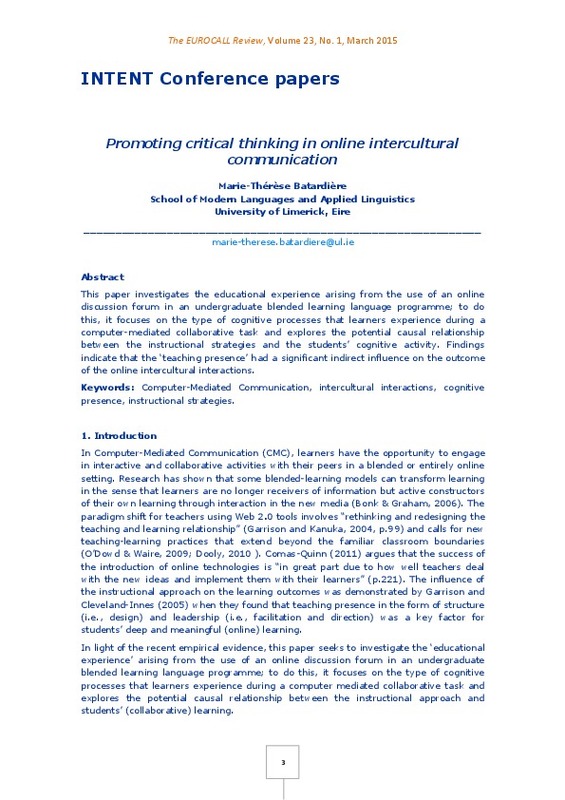Akyol, Z., & Garrison, D. R. (2011). Understanding cognitive presence in an online and blended community of inquiry: Assessing outcomes and processes for deep approaches to learning. British Journal of Educational Technology, 42(2), 233-250. doi:10.1111/j.1467-8535.2009.01029.x
Anderson, T., Rourke, L., Garrison, D.R. & Archer, W. (2001). Assessing teaching presence in a computer conferencing context. Journal of Asynchronous Learning Networks, 5(2), 1- 17.
Arnold, N., & Ducate, L. (2006). Future foreign language teachers' social and cognitive collaboration in an online environment. Language Learning & Technology, 10(1), 42-66.
[+]
Akyol, Z., & Garrison, D. R. (2011). Understanding cognitive presence in an online and blended community of inquiry: Assessing outcomes and processes for deep approaches to learning. British Journal of Educational Technology, 42(2), 233-250. doi:10.1111/j.1467-8535.2009.01029.x
Anderson, T., Rourke, L., Garrison, D.R. & Archer, W. (2001). Assessing teaching presence in a computer conferencing context. Journal of Asynchronous Learning Networks, 5(2), 1- 17.
Arnold, N., & Ducate, L. (2006). Future foreign language teachers' social and cognitive collaboration in an online environment. Language Learning & Technology, 10(1), 42-66.
Bonk, C. & Graham, C. (2006). Blended learning systems: definition, current trends, and future direction. In C. J. Bonk & C.R. Graham (Eds.), Handbook of Blended Learning: Global Perspectives, Local Designs, pp. 1-21. San Francisco, CA: Pfeiffer Publishing.
Brindley, J., Blaschke, L. M., & Walti, C. (2009). Creating Effective Collaborative Learning Groups in an Online Environment. The International Review of Research in Open and Distributed Learning, 10(3). doi:10.19173/irrodl.v10i3.675
Comas-Quinn, A. (2011). Learning to teach online or learning to become an online teacher: an exploration of teachers’ experiences in a blended learning course. ReCALL, 23(3), 218-232. doi:10.1017/s0958344011000152
Curtis, D., & Lawson, M. (2001). Exploring collaborative online learning. Journal of Asynchronous Learning Networks, 5(1), 22-34.
Dooly, M. (2010). The teacher 2.0. In S. Guth & F. Helm (Eds.), Telecollaboration 2.0: Language, Literacies and Intercultural Learning in the 21st Century, pp. 277-303. Bern: Peter Lang.
Garrison, D. R., Anderson, T., & Archer, W. (2001). Critical thinking, cognitive presence, and computer conferencing in distance education. American Journal of Distance Education, 15(1), 7-23. doi:10.1080/08923640109527071
Garrison, D. R., & Cleveland-Innes, M. (2005). Facilitating Cognitive Presence in Online Learning: Interaction Is Not Enough. American Journal of Distance Education, 19(3), 133-148. doi:10.1207/s15389286ajde1903_2
Garrison, D. R., & Kanuka, H. (2004). Blended learning: Uncovering its transformative potential in higher education. The Internet and Higher Education, 7(2), 95-105. doi:10.1016/j.iheduc.2004.02.001
Hanna, B., & de Nooy, J. (2003). A funny thing happened on the way to the forum: electronic discussion and foreign language learning. Language Learning and Technology, 7(1), 71-85.
Hanna, B. E., & de Nooy, J. (2009). Learning Language and Culture via Public Internet Discussion Forums. doi:10.1057/9780230235823
Levy, M., & Stockwell, G. (2006). CALL Dimensions: Options and issues in computer-assisted language learning. New Jersey: Lawrence Erlbaum Associates.
O’Dowd, R., & Waire, P. (2009). Critical issues in telecollaborative task design. Computer Assisted Language Learning, 22(2), 173-188. doi:10.1080/09588220902778369
Shea, P., Hayes, S., & Vickers, J. (2010). Online instructional effort measured through the lens of teaching presence in the community of inquiry framework: A re-examination of measures and approach. The International Review of Research in Open and Distributed Learning, 11(3), 127. doi:10.19173/irrodl.v11i3.915
[-]








